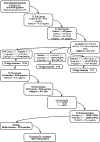Vector competence of Rhipicephalus sanguineus sensu stricto for Anaplasma platys
- PMID: 32993937
- PMCID: PMC7571858
- DOI: 10.1016/j.ttbdis.2020.101517
Vector competence of Rhipicephalus sanguineus sensu stricto for Anaplasma platys
Abstract
Anaplasma platys is a Gram-negative, obligate intracellular bacteria that causes canine infectious cyclic thrombocytopenia in dogs. The brown dog tick Rhipicephalus sanguineus sensu lato is presumed to be the vector of A. platys based on the overlap in distribution of R. sanguineus and A. platys infections, detection of A. platys DNA in both flat and engorged field-collected R. sanguineus, and the fact that dogs are primary hosts of both brown dog ticks and A. platys. However, the only study evaluating the vector competence of R. sanguineus for A. platys under controlled laboratory conditions reported an apparent inability of ticks to acquire or maintain the pathogen. In 2016, engorged female Rhipicephalus sanguineus sensu stricto ticks were collected off dogs to start a laboratory tick colony. After one generation of colony maintenance on tick-naïve and pathogen-free New Zealand White rabbits, a rabbit used to feed F1 adults seroconverted to Anaplasma phagocytophilum antigen. PCR and subsequent DNA sequencing identified the presence of A. platys in both the adult ticks fed on this rabbit and their resulting F2 progenies. Retrospective testing of all previous (P and F1) life stages of this colony demonstrated that the infection originated from one field-collected A. platys-infected female whose progeny was propagated in the laboratory and produced the PCR-positive F1 adults. Over the following (F2-F4) generations, the prevalence of A. platys in this colony reached 90-100 % indicating highly efficient transovarial and horizontal transmission, as well as transstadial maintenance, of this pathogen by R. sanguineus s.s.
Keywords: Anaplasma platys; Transovarial transmission; Vector competence.
Published by Elsevier GmbH.
Conflict of interest statement
Declaration of Competing Interest
The authors declare no conflicts of interest.
Figures
References
Publication types
MeSH terms
Supplementary concepts
Grants and funding
LinkOut - more resources
Full Text Sources
Miscellaneous


